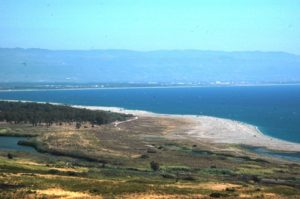 Gizzeria has no remote origins, despite being part of an archaeological area of considerable importance. The only certain information of the first constitution of the country does not go beyond the Byzantine period.
Gizzeria has no remote origins, despite being part of an archaeological area of considerable importance. The only certain information of the first constitution of the country does not go beyond the Byzantine period.
The etymology of the toponym Gizzeria is also very controversial. Some believe it deriving from the Greek Izwsios = to be placed.
The Izaria form is instead due to the Albanian migration. In the Norman period the name was, on the contrary, Yussaria. From Izaria later derived Jzaria (1510), then mutated, for phonetic reasons, into Jazzaria or Jizzeria. The current name is in use since 1753.
The history of the town, after the destruction by the Saracens, which took place towards the end of the year one thousand and precisely 981, according to some historical sources, is mainly centered, in the first centuries, on the Greek monastery of S. Nicola, a small cluster of few inhabitants, mostly housed in haystacks and habitats.

Located between S. Eufemia and Falerna and between Mount Mancuso on one side and the Serre Mountains on the other, it is particularly windy in some moments of the day and has now become an important destination for windsurfers and in particular kitesurfers.
The cenoby, which stood on a land belonging to the Knights of Malta, had at first an independent life, lasting until Roberto il Guiscardo granted it to the famous Benedictine abbey of S. Eufemia. Around this community, the first nucleus of the village of Gizzeria developed, a country that would not have had a further development if it had not been invigorated by the contribution of some Albanian refugees, who came to southern Italy to tame the revolt. of the Calabrian barons, led by Antonio Centelles, who had rebelled against the king of Naples Alfonso I of Aragon.
From several sites in the upper area of the mountain you can enjoy a beautiful view towards the sea which, especially in the Piano di Lizza, offers the possibility to see the gulf in its entirety. Generally the island of Stromboli is visible, one of the Aeolian islands of volcanic nature, but when the horizon is clear and clear the view is completed with the presence of the other Aeolian islands and sometimes also with Etna, the latter maybe even snowy, painting an extraordinary scenario.

The Albanian troops, led by Demetrio Reres, specially sent by the national hero Scanderberg, contributed valiantly to regain Calabria. Finally, Reres established in Reggio, and where his companions who founded, between 1448 and 1450, Gizzeria and many other towns in the province of Catanzaro.
 The first Albanian settlers, almost all poor and not respectful of neighbors and feudal power, were forced to make raids for the campaigns that gave rise to continuous complaints from the damaged populations. Only when they were precluded any hope of being able to return to their homeland, Albania, they were obliged to accept the vassalage of the Knights of Malta.
The first Albanian settlers, almost all poor and not respectful of neighbors and feudal power, were forced to make raids for the campaigns that gave rise to continuous complaints from the damaged populations. Only when they were precluded any hope of being able to return to their homeland, Albania, they were obliged to accept the vassalage of the Knights of Malta.
From the constitution in “universitas”, between 1558 and 1574, its history as that of many other small Calabrian centers, does not offer elements of particular novelties for centuries. Only at the end of the eighteenth century, and since the advent of the French, the village seems to shake off such an atavistic torpor, reserving a good reception to the revolutionary army departments, but then to change their minds in 1806, when Gizzeria accepted to shot those Frenchmen who had to stay there for three years.
In ’48 it is reported the presence of several gizzerioti in the battle of Angitola, during which they would give good evidence of their value against the Bourbon militia. Even a Mazzini cell rose and prospered, animated mainly by Antonio Miceli and that Alessandro Toj a, which we will find again among the thousand of Garibaldi. The only vestiges of this historical route are the buildings of worship and the few middle-upper-middle-class buildings, with some search for ornamentation recalculating “neoclassical” forms. The Church of the Annunciation and the Parish Church dedicated to St. John the Baptist are of some interest. We also remember the ruins of a third church annexed to the convent of St. Francis of Assisi, which can be traced back, according to a local researcher, to 1500.

The Albanians had brought in their new lands, along with their language, their traditions, their customs, their uses. The commonality with other families from other areas of Calabria, especially after the two disastrous earthquakes of 1638 and 1783, trade, relations, marriages with people from neighboring countries, greatly changed the character of the population, preparing the progressive disappearance of the arbresh idiom. Duration up to the end of the 19th century, today the Albanian language is no longer remembered and a small trace remains only in some single words, while the traditional female costume survives, with some variations. During Fascism the territory of Gizzeria was considerably reduced. The intense reclamation activity, prepared by the government in 1928 and aimed at the complete exploitation of the hydrogeologically disrupted land, underlined, in fact, the Piana di S. Eufemia, swampy and continuous source of malaria for the few inhabitants (in all 200), to a rehabilitation work. Thus restored the natural balance of the plain, the fascist government also built the new village of St. Euphemia, built according to the patterns of the architecture of the time with an octagonal plan and a square in which converged eight streets and around which new structures gravitated.
The population, in this second post-war period, suffered, as in all the small municipalities of the southern latifundium, a considerable decline following a massive migratory flow oriented mainly towards Switzerland, Germany (temporary) and France, Australia , the Americas (stable) and towards the cities of the Italian industrial triangle.
Even here, as in many other towns in Calabria, religious holidays are started with the rite of Holy Week. Another significant celebration is the solemn one that takes place on June 24th in honor of the Patron Saint John the Baptist; the population celebrates this feast with faith always unchanged since the religious sentiment has been and is still alive and sincere.
The third Sunday of October of each year, instead, takes place in the district “Cona” the Fiera del SS. Rosario, established on October 2, 1886, over the course of time was likely to disappear due to several disputes, even if it was restored in 1921 by both the City Council of the city and the Prefectural Authority.